Science
Hippo Sweat Sunscreen
Would you slather yourself in hippo sweat to avoid sunburn? Even if you replied yes, perhaps you'd prefer that the unguent came in a tube, rather than straight off the back of a hippo.
Posted By: Paul - Fri Apr 03, 2009 -
Comments (7)
Category: Animals, Science, Body Fluids, Natural Wonders
Why Tinfoil Hats Don’t Work
You might have seen the newspaper reports last fall about this experiment. Here's how it was done.
Posted By: Paul - Fri Mar 27, 2009 -
Comments (4)
Category: Eccentrics, Science, Experiments, Psychology, Technology
Bertillon Measurements
You've probably heard of the Bertillon System, one of those discredited "scientific" theories detailing how body measurements indicated racial and/or criminal aspects of a person.Well, here's how the NYC Police Department went about securing Bertillon measurements, circa 1908--courtesy of the George Bain Collection at the Library of Congress.
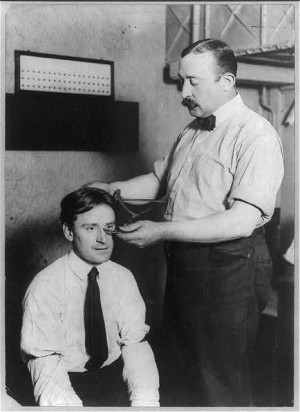
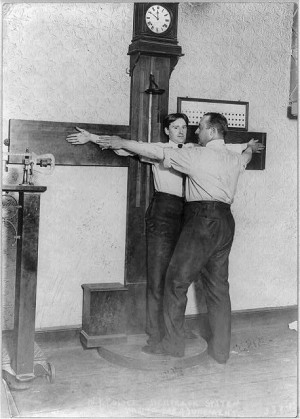
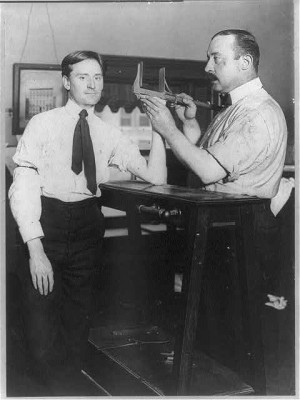
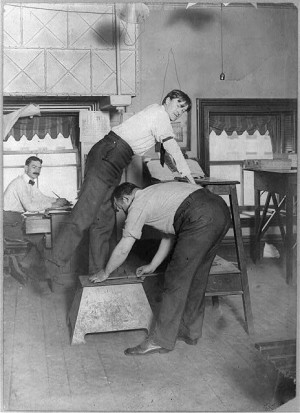
Posted By: Paul - Fri Feb 06, 2009 -
Comments (6)
Category: Crime, Fads, Science, Anthropology, Experiments, Stereotypes and Cliches, 1900s
Happy cows have names
News from the frontiers of science: Researchers have discovered that if you address cows by name, they produce more milk.The theory is that calling a cow by its name has a soothing effect on it. It feels more relaxed. Whereas unnamed, stressed out cows produce the hormone cortisol which suppresses milk production.
However, researchers warn that "just giving cows a name" probably won't do much. Ya gotta establish a relationship with the cow. Let it know you care. Link: Scientific American.
Posted By: Alex - Fri Feb 06, 2009 -
Comments (9)
Category: Science, Cows
Snarge
I learned something new after the US Airways flight crash-landed in the Hudson. When birds fly into jet engines, the resulting "bloody goo" that they're transformed into is called "snarge".A Sep 2004 article in Flying Safety magazine provides some further details about snarge.
- The most common method of collecting snarge is "by spraying the impact point on the aircraft with a water bottle and swiping it down with a paper towel."
- Snarge is "Smelly by nature, and often packed with mold spores, gooey bird fat or amorphous bits of flesh."
- Snarge looks like "something you find in your handkerchief after a bad cold."
- However, bird experts regard snarge as "the ultimate identification challenge!"
Posted By: Alex - Mon Jan 19, 2009 -
Comments (5)
Category: Animals, Flight, Science
Decomposition of a Pig
A time-lapse movie of a decomposing pig, taken by Dr. Jerry Payne in the 1960s as part of his graduate studies. It's four days compressed into six minutes. Not much happens at first, but around the 3 minute mark things get pretty interesting. There's a nasty little surprise at the end as well. (Note: the pig died of natural causes.)The purple dots that appear around 2:40 are beads to show the movement of soil by insects.
You may not want to watch this while you're eating a meal.
Posted By: Alex - Thu Jan 08, 2009 -
Comments (13)
Category: Death, Science, Experiments
Cat-Rat Cooperation Disproves Darwin
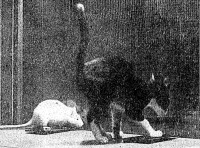 Chuck's post last week about the guy who trained a rat to sit on top of a cat sitting on a dog, reminded me of the groundbreaking research of Dr. Loh Seng Tsai, conducted back in the late 1940s/early 1950s.
Chuck's post last week about the guy who trained a rat to sit on top of a cat sitting on a dog, reminded me of the groundbreaking research of Dr. Loh Seng Tsai, conducted back in the late 1940s/early 1950s.Dr. Tsai trained a cat and a rat to cooperate together in order to get food. From the LA Times, July 15, 1951:
To get into the third section, where a dish of food awaits, the cat and mouse must each step on a floor button simultaneously. When this is done by perfect cooperation the gate drops and both animals thus gain admittance to the food chamber.
Dr. Tsai reported that, "Soon all the pairs of cats and rats began to work together. Finally their cooperation was so perfect that they took only three seconds to reach their food from the entrance."
Dr. Tsai figured that these results disproved Darwin's concept of the Survival of the Fittest. He told the LA Times reporter: "In the face of the fact that even alley cats and rats live together, eat together, sleep together, play together and work together, Darwin's theory seems at most only a half-truth."
What's really amazing is that this guy was a professor of biology at first the University of Chicago, then Tulane, then UCLA, and yet he didn't seem to have a clear understanding of what Darwin meant by the Survival of the Fittest. Nor, as far as I can tell, did anyone ever call him out as a crackpot. In fact, there was talk of nominating him for the Nobel Peace Prize.
Posted By: Alex - Tue Dec 23, 2008 -
Comments (6)
Category: Animals, Science, Experiments
Dr. Dove’s Unicorn Bull
 In 1933 Dr. W.F. Dove, a biologist at the University of Maine, conducted an experiment to find out if he could create a "unicorn bull." He removed the two knots of tissue on the side of the bull's head that would normally have developed into horns and transplanted them to the center of the forehead. The experiment was a success. A single, massive horn grew there.
In 1933 Dr. W.F. Dove, a biologist at the University of Maine, conducted an experiment to find out if he could create a "unicorn bull." He removed the two knots of tissue on the side of the bull's head that would normally have developed into horns and transplanted them to the center of the forehead. The experiment was a success. A single, massive horn grew there. The unicorn horn made the bull the unchallenged leader of its herd. But Dr. Dove observed that the unicorn bull was actually an extremely docile creature. He wrote:
Link: Unicorn Garden
Posted By: Alex - Wed Dec 17, 2008 -
Comments (5)
Category: Animals, Science, Experiments, 1930s
Eating Glass
The new Google magazine archive is a goldmine for weirdness. Here's another find from Popular Science, Nov 1931:Glass beads, strands of knotted thread, and even tiny pellets of gold is the diet of Frederick Hoelzel, Chicago, Ill., university student, since he offered to aid physiologists of the University of Chicago in research work on indigestion. The foreign objects are mixed with his meals, and his stomachaches come under laboratory scrutiny. They are no novelty to the subject of this unusual experiment; he volunteered for the tests because he already suffered from severe digestive troubles.
The full results of Hoelzel's glass-eating study were published in the American Journal of Physiology, (Mar 1, 1930), "The Rate of Passage of Inert Materials Through the Digestive Tract." The article includes a helpful chart, detailing exactly how long it took for various substances (including steel ball-bearings and bent silver wire) to pass through Hoelzel's system:

 Hoelzel was an interesting character. He became an expert on nutrition and often subjected himself to grueling diet experiments -- particularly experiments involving fasting for extended periods of time. The Life photo archive has a picture of him, taken in 1955. He seems to have been one of the first researchers to make a link between calorie-restriction and longevity, though it didn't really work for him. He died in 1963 at the age of 73.
Hoelzel was an interesting character. He became an expert on nutrition and often subjected himself to grueling diet experiments -- particularly experiments involving fasting for extended periods of time. The Life photo archive has a picture of him, taken in 1955. He seems to have been one of the first researchers to make a link between calorie-restriction and longevity, though it didn't really work for him. He died in 1963 at the age of 73.
Posted By: Alex - Fri Dec 12, 2008 -
Comments (8)
Category: Food, Nutrition, Science, Experiments
The Hard-To-Get Woman
Why do women play hard to get? According to research recently conducted at the University of Bristol, it's so that "men can prove themselves more worthy than their rivals."Here's how it works. The woman acts coy. The man acts eager and helpful. Eventually the woman decides, "I am going to have a child with this male." I assume she says this in a robotic voice.
The researchers hope their study "could eventually lead to a model that could work out the optimal amount of coyness for a woman to use in choosing a male."
I wrote about some similar research in Elephants on Acid. In 1973 researchers from the University of Wisconsin instructed a Nevada prostitute to play "hard to get," and then studied the reactions of her clients. Hard to get, in that context, meant that she didn't indicate to her clients whether she wanted to see them again. Client response was measured by the number of times the guy returned during the following month. The researchers concluded that men don't like women who play hard to get. Instead men like women who are easy for themselves but hard for everyone else to get. (Thanks, Sandy!)
Posted By: Alex - Tue Dec 09, 2008 -
Comments (7)
Category: Science, Experiments, Psychology, Women

| Who We Are |
|---|
| Alex Boese Alex is the creator and curator of the Museum of Hoaxes. He's also the author of various weird, non-fiction, science-themed books such as Elephants on Acid and Psychedelic Apes. Paul Di Filippo Paul has been paid to put weird ideas into fictional form for over thirty years, in his career as a noted science fiction writer. He has recently begun blogging on many curious topics with three fellow writers at The Inferior 4+1. Contact Us |




